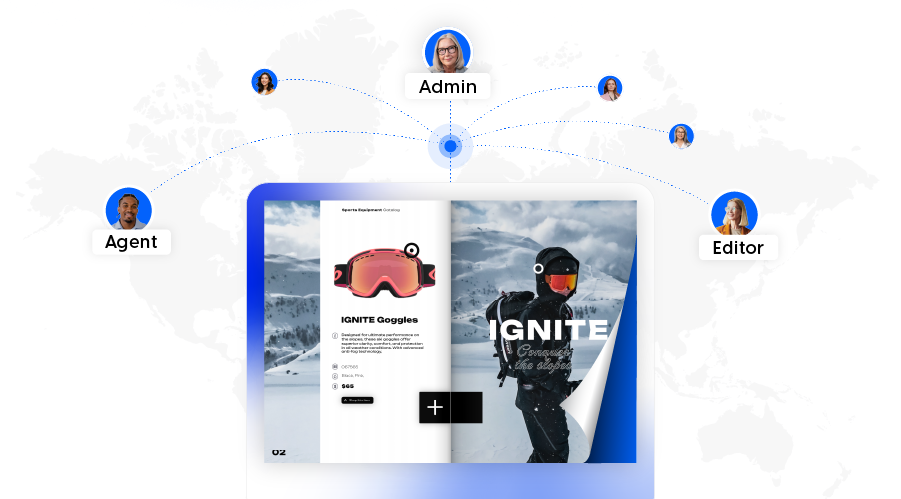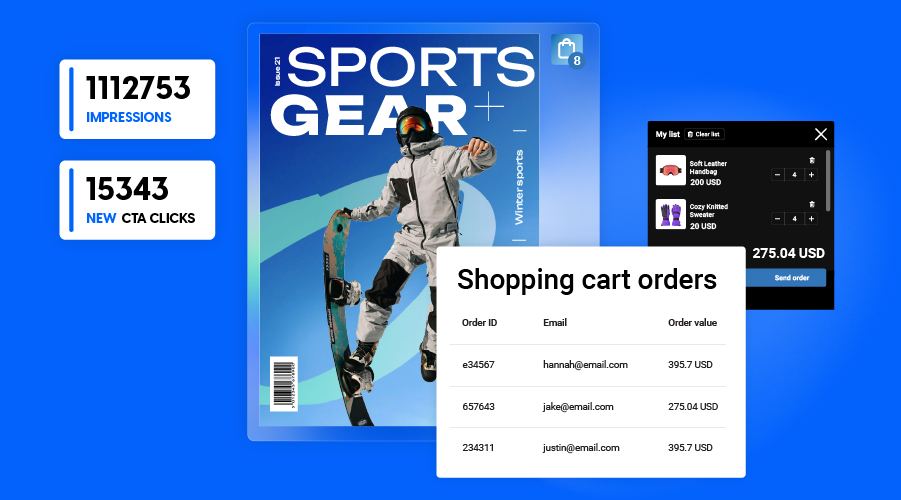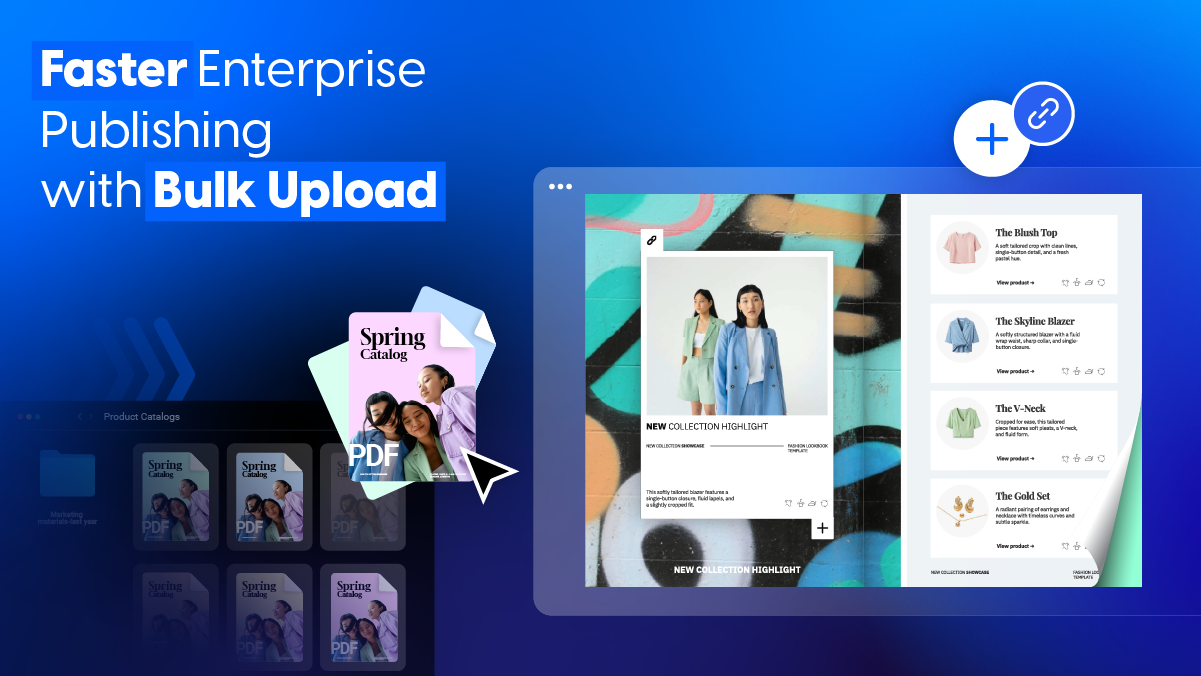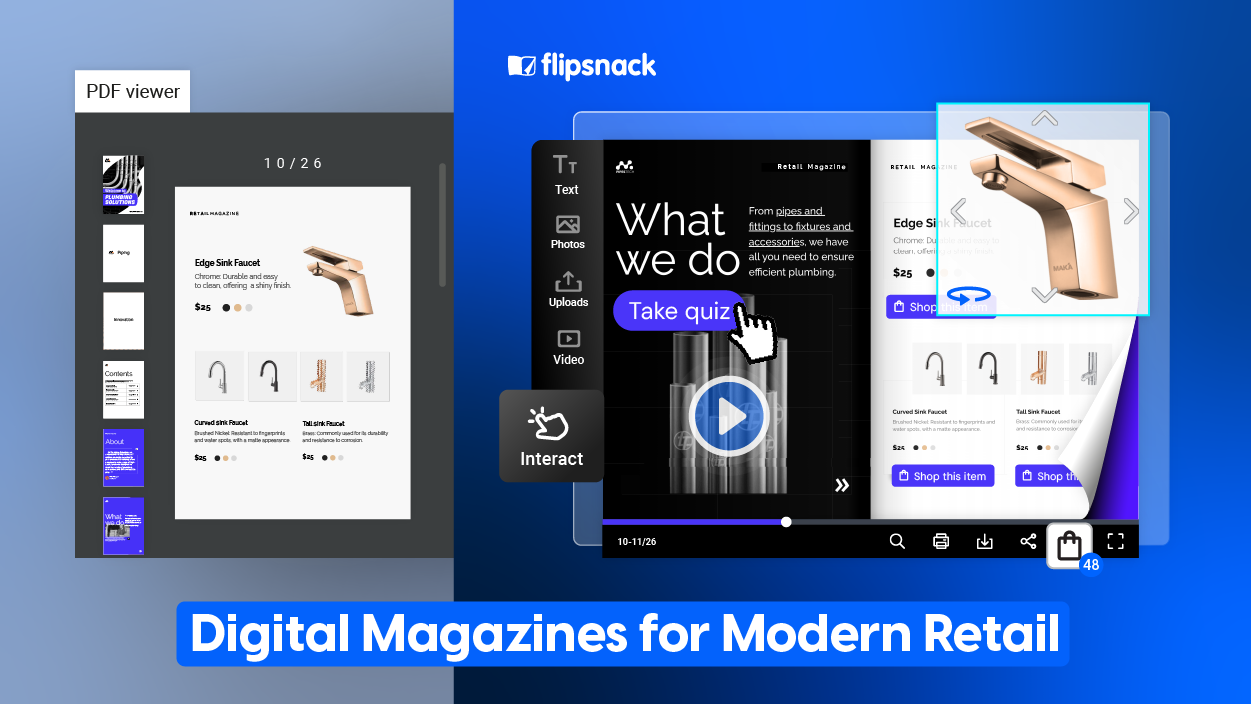Enterprise Publishing at Scale with Bulk Upload and Automation
Imagine this scenario: a regional airport needs to update the menus for a dozen different restaurants. Each menu is a digital publication, and each one needs to be perfect, with up-to-date prices, accurate allergen information for new dishes, seasonal specials, and corrected typos before they go live.
Or think about a major retailer tasked with creating and maintaining a single, searchable product catalog that spans over hundreds of pages. Every price change, discontinued product, or updated product description must be reflected instantly, with accurate stock availability and correct technical specifications for each item.
For enterprise-level businesses, managing this volume can be a massive challenge.
Static files, manual updates, and a lack of a clear system lead to version control headaches, branding errors, and a constant drain on your team’s time.
The real goal is to have a scalable content strategy that allows you to manage hundreds of publications smoothly. A system that scales with your business, not against it.
Table of contents
The problem with the old way

Most content teams get stuck. They are caught in a cycle of creating new PDFs, emailing them for review, and manually tracking changes. This process is slow, prone to errors and things like:
1. Fragmented workflows
The journey of a single publication often involves multiple tools that don’t connect: a designer creates a file, sends a PDF via email, a manager gives feedback in a separate document, and the file is stored in a shared drive. This disjointed process makes it nearly impossible to keep track of progress.
2. Version control challenges
Without a single source of truth, it’s a constant struggle to know which file is the most recent and approved version. Has a final change been implemented? Is this the right document for distribution? These questions lead to delays, confusion, and costly errors.
3. Repetitive, manual tasks
Every new publication, or even a minor update, requires a full round of manual work. Teams are forced to spend their time on tedious, repetitive tasks.
This traditional approach is a roadblock to high-volume content management. It’s an unsustainable model for any company that wants to manage a large number of digital publications.This is where a digital publication platform with catalog automation changes everything.
A better way: scale your enterprise publications with Flipsnack
Flipsnack provides an end-to-end enterprise publishing solution for managing publications at scale. It’s a platform for creating interactive PDFs either by uploading existing files, starting from customizable templates, or designing from scratch.
Companies can centralize all their enterprise publications in one place, ensuring brand consistency and easy access across teams. It’s designed to transform chaotic processes into a streamlined, efficient workflow, especially for catalogue production and other recurring, high-volume projects.
Let’s take it one feature at a time.
1. Bulk upload for fast catalog creation
Instead of manually creating and updating hundreds of pages, Flipsnack’s content workflow automation features allow you to instantly generate entire publications from a simple spreadsheet.
You can connect your product data from Google Sheets, a CSV file, or an Excel file, and Flipsnack automatically fills your catalog with the product names, descriptions, images, prices, and other details from your spreadsheet. In other words, you set up your data once, and the platform instantly arranges it into your chosen catalog layout without you having to manually copy and paste each item.
This not only saves countless hours but also ensures your publications are always up-to-date with the latest product information. All your content lives in a single, organized dashboard, so your team always knows where to find the latest version.
Flipsnack also supports live updates. Change a single data point in your source file and instantly push those changes across all linked publications. Whether it’s a product price, image, or description, updates happen everywhere at once without re-exporting or re-uploading.
For businesses producing frequent catalog updates, this means your automatic catalog stays accurate without additional manual work.

2. Brand consistency
When enterprises manage hundreds of publications a year, branding is one of the first things to slip.
With dozens of people involved in creation and distribution, even small deviations in color, logo placement, or typography can erode a company’s identity. The only way to scale without losing control is to make branding non-negotiable and to have systems in place that enforce it automatically.
Flipsnack gives enterprise teams that level of brand control on different levels:
2.1 Content creation
You’ll have a built-in brand library that keeps all brand assets such as logo, colors, and fonts in one centralized location, ready to apply instantly to any publication. You can upload and manage these assets directly from the Branding section in your Flipsnack Dashboard.
Locked templates protect your visual identity by fixing layouts while still allowing teams to update text and images as needed. You can decide exactly which elements stay locked, such as logos, and which can be edited. This prevents accidental or unauthorized changes, ensures every publication follows brand guidelines, and lets teams create on-brand materials faster using saved, ready-to-use templates.
Think of a hotel chain producing seasonal menus for 150 locations. Each with local pricing and specials. Locked templates keep the layout, branding, and core messaging identical across all versions, no matter who updates them.
2.2 Role-based permissions
Assign clear roles for creating, editing, and publishing. This ensures only approved team members can make changes or push content live, reducing the risk of off-brand materials entering circulation.
Admins have the same permissions as the owner and can manage all aspects of the account, including all flipbooks and settings. Editors can fully create and edit flipbooks but cannot access Billing or account Settings. Agents work only on their own flipbooks, without access to Billing or Settings, while Contributors can create, edit, and view their own flipbooks but need an Owner, Admin, or Editor to publish them.
This structure ensures content stays secure, workflows remain organized, and publishing rights are clearly defined across the team.
2.3 Consistent distribution
You can publish on your own domain or subdomain so every publication is tied directly to your brand, with no outside labels attached.
When sharing via email, you can customize every detail — from the logo and title to the background and visuals — so each touchpoint reinforces your identity.
With Flipsnack, enterprises can create and send interactive newsletters (flipbooks) that look and feel like an extension of their website or marketing materials. Whether you upload a ready-made PDF or start from a template, you can add interactive elements like videos, clickable CTAs, and embedded links directly inside the newsletter.
The email itself can feature your brand colors, header image, and personalized messaging, linking readers straight to your flipbook. This ensures recipients experience a seamless, on-brand journey from inbox to publication.
Enterprises can also use private or password-protected publications or deactivate a publication to control access.
For an even more secure and streamlined approach, Flipsnack offers SSO sharing for viewers, allowing organizations to make publications accessible only to users authenticated through their existing SSO system, such as Okta, Azure Active Directory, or Google Workspace.
This means authorized readers can open flipbooks without creating a separate Flipsnack account, making it easier to distribute sensitive materials like internal manuals.
2.4 Scaling without losing consistency
With centralized assets, locked design standards, controlled access, and fully branded distribution, you can manage hundreds of publications without sacrificing brand integrity. Every piece, no matter who creates it, delivers the same clear and consistent brand message.
3. Team collaboration

Managing content across a large team can quickly spiral into delays, confusion, and off-brand results. Flipsnack streamlines the process by bringing creation, feedback, and approvals into one place. Every step is visible, controlled, and aligned with your brand.
- Centralized workspace: Organize projects by department or purpose and keep all work in one secure location.
- Secure team access: Invite members through SSO and control who joins your workspace.
- Role-based permissions: Assign clear roles for creating, editing, or publishing to prevent unauthorized changes.
- In-document feedback: Add comments and notes directly on publications to replace messy email chains.
- Real-time editing: See who is working on a publication and avoid overwriting someone else’s changes.
A global sales team, for instance, can review a new B2B catalog directly in Flipsnack, adding comments next to each product listing. Marketing can make changes instantly, avoiding long email chains and mismatched file versions.
With these tools, approvals happen faster, mistakes are caught early, and every piece of content stays on-brand, whether it’s a product brochure or an automatic catalog update.
4. Integrations & scalability
Flipsnack connects with the systems enterprises already use. From Single Sign-On (SSO) for secure access to API integrations for automated publishing, the platform fits into existing IT environments.
Your data is always protected through enterprise-grade security, including ISO-certified protocols and GDPR compliance.
This means publications can be embedded on websites, intranets, or sales portals, and data can flow in from CRMs or DAM systems to keep content fresh without manual intervention. This makes it a true enterprise content management (ECM) solution that supports automated catalog management and other high-frequency publishing needs.
5. Track performance with analytics

Beyond creation and distribution, Flipsnack provides advanced analytics so you can measure how your publications perform. Track opens, time spent per page, clicks, and even individual reader activity. These insights feed directly into marketing, sales, and product decisions, making every publication a measurable asset.
Customer spotlight: Electrolux Group
Electrolux Group faced the challenge of keeping hundreds of product catalogues accurate, engaging, and easily accessible for trade partners across 17 countries. Printing was slow, updates were cumbersome, and creating multiple catalogue versions for different markets consumed significant resources.
They needed a sustainable digital solution that could speed up catalogue production, streamline distribution, and allow for easy updates.
Flipsnack delivered exactly that, providing a mobile-friendly, interactive platform with automation features that generated and updated catalogues directly from product data. This cut production time, enabled instant distribution, and enriched user experience with videos, product tags, and other interactive elements.
The results:
- 345 flipbooks created
- 104,400 catalogue impressions
- 76,300 product catalogue views
- 8,800 catalogue downloads

Conclusion
With Flipsnack, enterprises move from fragmented, manual workflows to a single, controlled system that scales.
The result is faster publishing, stronger brand consistency, better compliance, and data-driven insights all without adding headcount or sacrificing quality.
Whether you’re managing a dozen publications or thousands, the process stays smooth, secure, and fully aligned with your business goals.




